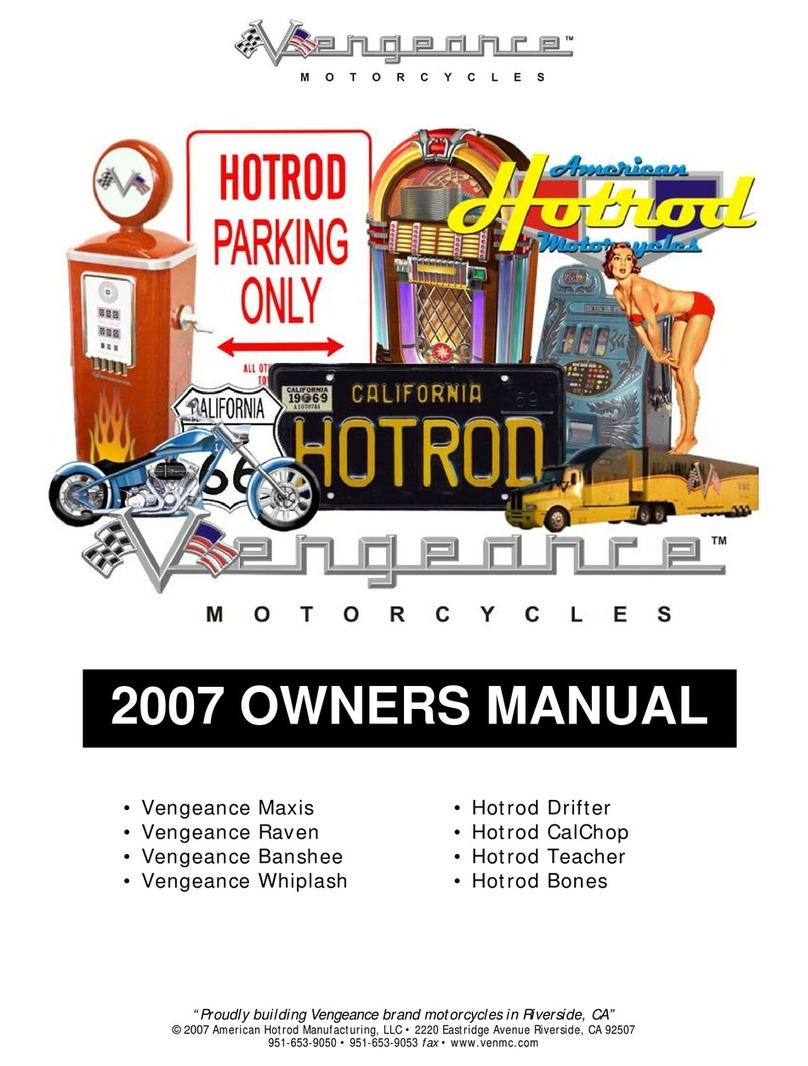
VENGEANCE MOTORCYCLES OWNERS MANUAL
- 5 -
Vengeance Motorcycles, Mira Loma, CA USA • 866-483-6432 • www.VengeanceMotorcycles.com
© 2003 Vengeance Performance Products, LLC All Rights Reserved • VOM 1st Edition Rev 2.3 06/03
TABLE OF CONTENTS
Welcome.....................................................................................................................................................................3
Notes, Cautions, and Warnings..................................................................................................................................4
“You and Your Motorcycle” - Riding Tips from the Motorcycle Safety Council ..........................................................7
Forward..........................................................................................................................................................7
Introduction ....................................................................................................................................................7
The Rider – What to wear When You Ride ...................................................................................................8
You and Your Legal Responsibilities.............................................................................................................9
Know Your Motorcycle.................................................................................................................................10
The Highway, Byway, Street and Alley........................................................................................................13
Handling Special Situations.........................................................................................................................15
Equipment Failures......................................................................................................................................17
Group Riding and Passengers ....................................................................................................................18
Loading the Motorcycle ...............................................................................................................................19
Drugs, Drinking and Driving.........................................................................................................................19
Conclusion ...................................................................................................................................................19
Motorcycle Skill Test Practice Guide ...........................................................................................................20
Familiarization – Major Components ........................................................................................................................26
Vehicle Identification Number......................................................................................................................26
Frame ..........................................................................................................................................................26
Suspension System .....................................................................................................................................27
Powertrain....................................................................................................................................................28
Braking system ............................................................................................................................................29
Electrical System .........................................................................................................................................30
Fuel System.................................................................................................................................................31
Controls and Operations...........................................................................................................................................33
Ignition-Light Key Switch .............................................................................................................................33
Instrument Cluster .......................................................................................................................................34
Speedometer ...............................................................................................................................................35
Turn Signal Indicators..................................................................................................................................36
Headlamp Hi/Lo Switch ...............................................................................................................................37
Electric Starter .............................................................................................................................................37
Engine Stop Switch .....................................................................................................................................38
Horn .............................................................................................................................................................38
Throttle Control Grip ....................................................................................................................................39
Fuel Supply Valve........................................................................................................................................39
Fuel Enrichener Controls.............................................................................................................................40
Fuel Caps ....................................................................................................................................................40
Brake System ..............................................................................................................................................41
Brake Light...................................................................................................................................................41
Clutch Hand Lever .......................................................................................................................................41
Gear Shifter .................................................................................................................................................42
Mirrors..........................................................................................................................................................42
Kickstand .....................................................................................................................................................43
Starting Your Motorcycle ..........................................................................................................................................44
Cold Starting ................................................................................................................................................44
Hot Starting..................................................................................................................................................44





























